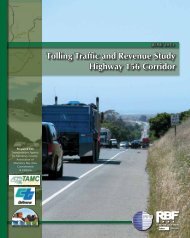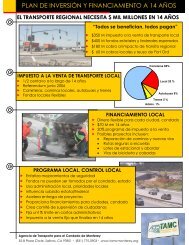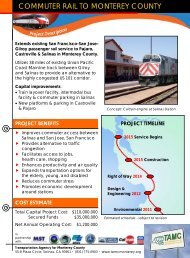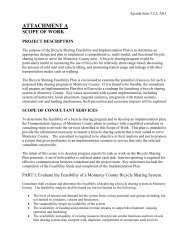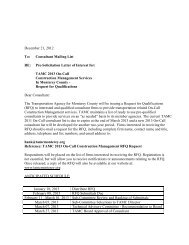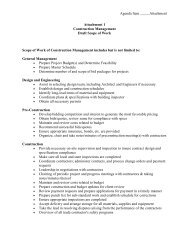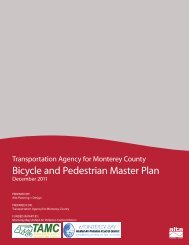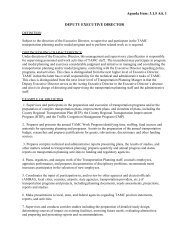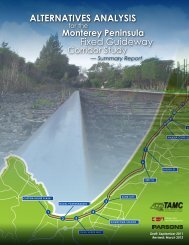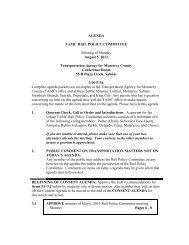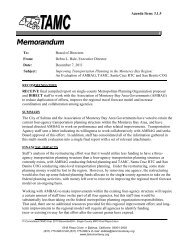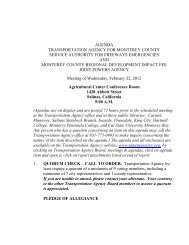Commuter Rail Extension Alternatives Analysis - Transportation ...
Commuter Rail Extension Alternatives Analysis - Transportation ...
Commuter Rail Extension Alternatives Analysis - Transportation ...
You also want an ePaper? Increase the reach of your titles
YUMPU automatically turns print PDFs into web optimized ePapers that Google loves.
CALTRAIN EXTENSION TO MONTEREY COUNTYALTERNATIVES ANALYSISCHAPTER 1: INTRODUCTIONOVERVIEW OF MONTEREY COUNTY FIXED GUIDEWAY STUDYThe Monterey County Fixed Guideway Study considers major transit capital investment for intercountycommuting and intra-county travel needs. Inter-county commuting consists of travel betweennorthern Monterey County and southern Santa Cruz County to the San Francisco Bay Area. Intracountytravel consists of trips along the Monterey Peninsula and trips between the MontereyPeninsula and Salinas. Figure 1-1 illustrates and summarizes the travel markets considered by theMonterey County Fixed Guideway Study.The Monterey County Fixed Guideway Study had its origins in 1990 with the passage of Proposition116, a California voter initiative which identified Monterey County as a recipient of rail bond capitalfunds for passenger rail projects within the county.In 1990, the Governor approved Assembly Bill No. 222, which appropriated $100,000 for a rail passengerfeasibility study for the Gilroy–Monterey portion of the San Francisco–Monterey rail corridor.Passenger <strong>Rail</strong> Feasibility Study No. 05D423 was prepared for the California Department of <strong>Transportation</strong>(Caltrans) District 5 in 1992 and finalized in September 1993. It addressed the feasibility ofpassenger rail service between San Francisco, Monterey, Salinas, and Hollister. The study found amarket for work trips using passenger rail between Salinas and Silicon Valley, and indicated thatservice to Salinas would be the most feasible short-term corridor due to the presence of existing railfacilities. A daily schedule of two northbound trains departing from Salinas and two southbound trainsterminating in Salinas was recommended.Subsequent to this study, Monterey County officials apportioned the Proposition 116 bond fundingbetween the U.S. 101 Corridor and Monterey Peninsula travel markets.U.S. 101 Corridor ElementInsofar as the U.S. 101 Corridor fixed guideway alternative(s), project scoping activities for anextension of Caltrain to Monterey County have been ongoing since 1996. From June 1996 to June1998, the City of Salinas sponsored investigations of development options for a Salinas Intermodal<strong>Transportation</strong> Center to be developed at the site of the existing Amtrak Station. Phase 1 of thetransportation center, consisting of bus layover bays, surface parking, site landscaping and lighting,was subsequently constructed and placed into operation in 1999.In 1997, the City of Watsonville prepared a Draft Pajaro Valley Station Project Study Report, incooperation with Monterey County, the <strong>Transportation</strong> Agency of Monterey County (TAMC) and theSanta Cruz County Regional <strong>Transportation</strong> Commission. While not finalized, the draft project studyreport (PSR) identified a potential site location and set of program requirements for this station.During the time period from 1998 to 2000, these program requirements and opportunities for adjacentsite development were further refined and explored by a Monterey County–sponsored Pajaro<strong>Rail</strong>yards Area Feasibility Study. This study, as well as the draft PSR, sited the Pajaro Valley Stationadjacent to the former Southern Pacific Passenger Depot, accessed from Salinas Road.parsons CHAPTER 1: INTRODUCTION 1



